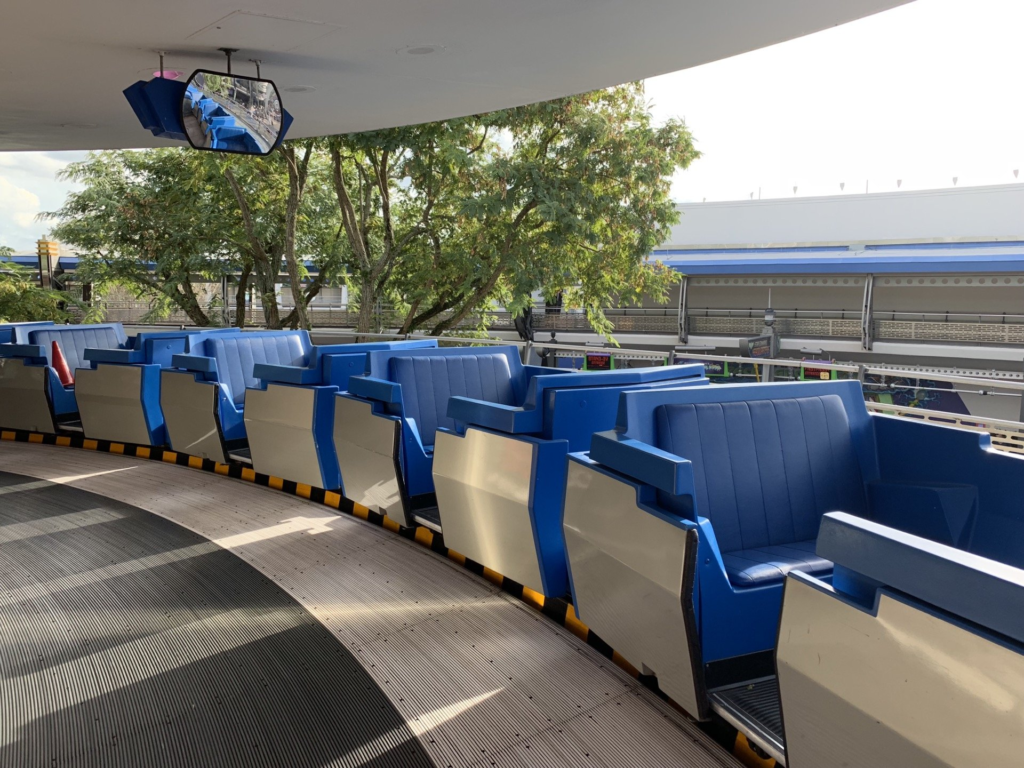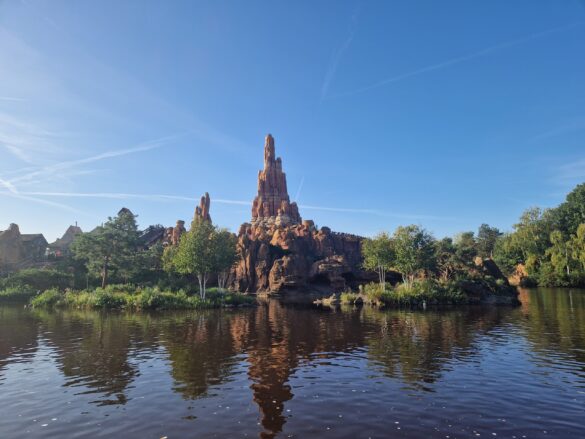
The Omnimover Ride System History
Last Updated on February 10, 2024 by Themepark Freak
Have you been to a Disney Theme Park and ridden one of the rides where the carts are continuously moving, tilt and/or swivel on the track? This is known as the Omnimover Ride System.
Lets dive a little more into this particular ride system and it’s history!
The Omnimover Predecessor – The PeopleMover

The Ford Magic Skyway featured full size Ford vehicles as the ride “car” which continuously moved. The riders would move along with the car on a moving walkway to load or unload. The problem with this attraction (besides being a concept for the World’s Fair) is the cars were big and you could only move so many people an hour. Plus, Walt needed to revitalize Tomorrowland from it’s World’s Fair attractions.
Enter the PeopleMover. In July 1967, this attraction replaced the Ford Magic Skyway as part of the new Tommorowland.

Smaller cars replaced the full sized Ford cars, improving the efficiency of the attraction. The drive mechanism was also improved so it was more reliable and took less wear and tear. They (the Imagineers) also worked on the spacing between the cars and programmed it to go faster so they could fit more cars on the track. And, of course, riders loaded and unloaded via a constantly moving walkway in the form of a turn table.
This ride mechanic was so good at “moving people” that Walt and the Imagineers started implementing this continuous ride system in other Disney projects.
Improving Upon the People Mover
In the 1964 World’s Fair the Ford Magic Skyway wasn’t the only ride system being featured. There was one particular system that provided inspiration to the Imagineers that would become today’s Omnimover Ride System.
Bell System Chair Ride
There were plenty of different unique ride systems that were being showcased at the World’s Fair. However, there was one that would lend inspiration for today’s Omnnimover Ride System. That would be the chair ride located in the Bell System Pavilion.
This particular attraction put each rider in it’s own chair that had it’s own sound system. The truly unique thing about this ride was that the chairs faced the wall. This meant that riders couldn’t look around and see everything like in Ford Magic Skyway or other attractions with open cars. Instead, guests had to look at what the dark ride wanted them to look at, immersing them into the story.
The Omnimover Ride System is Born
During a brain storming session, Imagineers came up with the idea of placing riders in a cart much like the ones featured in the Bell System Chair Ride but could swivel on the track. This would allow for riders to look forward like on traditional dark rides, or be forced to look at certain parts of the ride.

Once the idea was flushed out, it was passed over to the engineers who built the system.
So What is the Omnimover?

The Omnimover Ride System is just what the Imagineers conceptualized. A chain of carts that can swivel and/or tilt on a track that is often hidden under the floor. Different ride elements, lighting, lasers, and projections can be hidden behind the cart when it’s facing a certain direction. This means that the elements don’t have to be worked into the theming because guests will never see it.
The chain of vehicles also maintain a certain speed through the entire attraction. This means the loading and unloading utilize a conveyer belt that moves along with the ride to load and unload.
Attractions that Use(d) the Omnimover
The Omnimover was used for the first time in the 1967 Disneyland attraction Adventure Thru Inner Space.
- Adventure Thru Inner Space (Disneyland 1967-1987)
- Haunted Mansion (Disneyland 1969-Present)
- Haunted Mansion (WDW Magic Kingdom)1971-Present)
- World of Motion (WDW Epcot 1982-1996)
- Spaceship Earth (WDW Epcot 1982-Present)
- Horizons (Epcot 1983-1994)
- Journey into Imagination (WDW Epcot 1983-1986)
- Haunted Mansion (Tokyo Disneyland 1983-Present)
- Phantom Manor (Disneyland Park Paris 1992-Present)
- Buzz Lightyear’s Space Ranger Spin (WDW Magic Kingdom 1998-Present)
- BBuzz Lightyear Astro Blasters (Tokyo Disneyland 2004-Present)
- Buzz Lightyear Astro Blasters (Disneyland 2005-Present)
- Buzz Lightyear Astro Blasters (Hong Kong Disneyland 2005-2017)
- Buzz Lightyear Astro Blasters (Disneyland Park Paris 2006-Present)
- The Seas with Nemo & Friends (WDW Epcot 2007-Present)
- The Little Mermaid: Ariel’s Undersea Adventure (Disneyland 2011-Present)
- Under the Sea – Journey of the Little Mermaid (WDW Magic Kingdom 2012-Present)
- Buzz Lightyear Planet Rescue (Shanghai Disneyland 2016-Present)
- Ant-Man and the Wasp: Nano Battle (Hong Kong Disneyland 2019-Present)
Disney Omnimover Ride Variations
Between the introduction of the Omnimover Ride System in 1967 until today, a few variations have come out. They all use a continuous chain of cars, they all can swivel (except one) on the track and they all are loaded and unloaded with a conveyer belt. However, these are some of the variations that came about over time:
- Horizons was the one exception to the “swivel” the car on the track. Much like the Bell System ride, the Horizons cars stayed facing the wall. Instead of the track being under the floor, it was above the cars to give riders a sensation of flying.
- In the Seas with Nemo and Friends, the cars don’t tilt or rotate away from facing the wall. This was due to lack of space for the mechanisms below the track to make it tilt and whirl.
- In Buzz Lightyear, riders get to spin the car themselves.
- Journey into the Imagination came to a complete stop to allow riders to load and unload.
